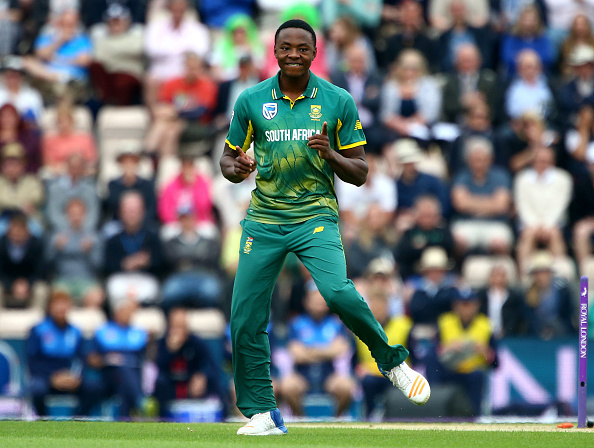The big-hitters grab the headlines and attention but it’s equally a fact that the team with the highest wicket-takers – or the most regular wicket- takers – tend to win tournaments like the Champions Trophy.
South Africa’s approach to ODI cricket was changed fundamentally by Gary Kirsten during his two-year tenure as national coach between 2011 and 2013 when the emphasis shifted from bowling dot balls to taking wickets. He was the first coach to subtly move away from South Africa’s ‘traditional’ strength towards a more proactive game plan in the field.
During Kirsten’s playing career, the team put a premium on dot balls, priding themselves in the field on saving every run as though their lives depended on it. A cover cordon inspired by Jonty Rhodes and led by him for over a decade created a procedure they referred to as ‘the strangle.’ It worked far more often than not, too. No team defended sub-par totals more often than South Africa.
But Kirsten had seen today’s future years earlier and knew the answer to success lay not in attempting to deny runs but by taking wickets.
One and the same thing, of course, but whereas South African teams had taken them as a consequence of building pressure in the past, he believed that attack rather than defence should become their priority.
Which brings us, today, to Kagiso Rabada. We’re never going to be in a Wasim Akram/Imran Khan situation where the great captain told his tearaway youngster “just bowl as fast as you can and don’t worry about wides and no-balls” – far too much of a leap away from core principles of discipline – but Rabada is under no illusions about his job. Especially in the first power-play.
A poster-boy for Transformation and the new demographic representivity of the Proteas team, the truth is more representative of the complexity of change. Transformation is about giving the previously disadvantaged a chance to compete, and shine. Just as the kids in the townships cannot be blamed for their demise, Rabada cannot be held responsible for the fact that he is one of the most privileged cricketers in South Africa.
His father is an acclaimed brain surgeon and his mother a lawyer who now works in the financial investment sector. Kagiso went to St Stithians College in Johannesburg and the family home is one to which most white families would have aspired even in the grimmest days of apartheid.
Dr Mpho Rabada was acutely aware of the danger that his son might grow up unaware of the realities the majority of South Africans face in day to day life and started taking his son into the townships of Soweto and Alexandra from as early as nine where he helped out in soup kitchens and other relief positions. A few years later he was collecting discarded shoes and other items of sports kit to distribute amongst the needy.
On the face of it, Rabada represents the opposite of what Transformation stands for. Yet, he is at the forefront of it. The requirement to play two Black Africans amongst six players of colour means, at the moment, he must play every game. Fortunately, he is amongst the best fast bowlers in the world and rapidly becoming one of South Africa’s best ever.
He also has mild scoliosis of the spine which, in normal circumstances, would mean a far more conservative approach to his workload than is currently the case. But he is 21 years old and wants to play every game. And that suits his country in more ways than one.
Mild of manner and temperament off the field, he often appears so on it, too, but that is deceptive.
The Under-19 World Cup-winning coach of 2014, Ray Jennings, says: “I told him that, as the leader of the attack, there were times when we needed aggression from him, we needed him to intimidate and, if necessary, be nasty – for the sake of the team. He listened, understood, and was very effective at complying.”
Charl Langeveldt, the current fast bowling coach, is just the latest to be surprised at Rabada’s willingness to learn. Despite the stunning statistics and records that have decorated the beginning of his career, he is, apparently, keen to remain a novice for as long as possible.
Having demolished England in the final Test match at Centurion with figures of 13-144 in February last year, the second best ever for a South African behind Makhaya Ntini, Rabada could have been forgiven for getting ahead of himself.
“You have a lot to learn about playing in Australia, on and off the field,” Langeveldt told him in October last year, with gravitas. “I know,” replied Rabada, “just tell me what I need to do. I want to learn.” And learn he did as South Africa won a third consecutive series down under.
Apart from extreme pace and an unusually well-developed ability to read the game and a batsman’s mood, one of his greatest assets is coping with ‘failure’. Or at least a lack of wickets. He has been conditioned, willingly, to expect failure. That much is obvious by the equanimity with which he accepts triumph and disaster. He speaks with the same, slightly monotonous but sincere, tone at a man-of-the-match presentation as he does following 0-100 in a provincial match.
He turned down an under-the-table $500,000 offer from an IPL franchise last year in order to play a less pressured six weeks for Kent. He backed himself to cash in later. This year he played for the Delhi Daredevils for $950,000. He knows what he wants, and wants what he knows.
Right now he wants wickets, early wickets preferably, as the leader of the small section of the current South African squad which has no scarring from previous ICC world events.
This piece originally featured in The Cricket Paper, June 2 2017
Subscribe to the digital edition of The Cricket Paper here













You raise a good point regarding the change in the South African approach to bowling. Indeed, it changed during Kirsten’s tenure as coach. You comment that Kirsten saw the future of the game. I have to disagree. It does happen in ODIs that teams are bowled out, but it’s a rare event – save for the Proteas in must-win games. For the most part, ODIs are won or lost based on the runs a team scores regardless of the wickets.
Kirsten replaced a very reliable approach with a high risk, all-or-nothing adventure. The strangle works, whether it results in wickets or not. Having your opponents finish their 50 overs at 200/0 is better than having them score 300/9.
It is noticeable that the current crop of Protea bowlers can’t contain their opponents under most circumstances, but in particular during the death overs. If you are only going to win those games where you manage to bowl out your opponents (third game against England in the warm-up), you’re not going to win the majority of your games.
And you can forget about making a serious challenge in any knock-out format.